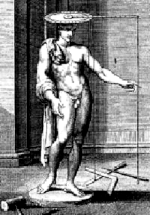Puncturing device
A puncturing device is a measuring device for making copies in sculpture .
The puncturing device is based on the stereometric law that a fourth point of any three fixed points in space can be defined by distance measurements.
function
Traditional puncturing device
At the beginning of the work, three fixed points must be determined both on the model and on the workpiece. The so-called puncturing cross is hung or placed on these points. A metal rod with several lockable ball joints is attached to the puncturing cross so that the entire surface of the model can be reached. At the end of the rod there is a displaceable needle, which is set up to scan a point on the model perpendicular to the surface. Now the rider is fixed on the needle in such a way that it rests against the stop of the rod. The point is marked with a pencil or the like. Then the needle is withdrawn within a parallel guide in the rod and the puncturing device is transferred from the model to the workpiece. After pushing the needle up to the workpiece, the sculptor can read from the distance between the stop and the rider how much material still has to be worked away at the point in question. By alternately working back the workpiece and measuring by pushing the puncturing needle, the sculptor slowly approaches the desired point. At the end, a small depression is made in order to rule out errors in the angle between the puncture needle and the surface to be created. The point found on the workpiece is also marked. Depending on the accuracy of the copy to be made, the points are set more or less densely. Only in the final processing are the points connected to one another and the actual surface of the sculpture is created.
Laser puncturing device
A future non-contact laser puncturing device enables simple, accelerated, precise work. There is no need to handle mechanics. It does not matter if the sculptor repeatedly interrupts the laser light, he can always continue working immediately.
A laser puncturing device requires a frame on a wall on which there is a horizontal base plane that can be moved up and down and carries 2 swiveling laser pointers. To capture a point on the surface of a sculpture, the base plane is first brought to the correct height (z) using an electric linear motor that drives a suitable reduction gear. Then the two laser pointers (x, y) are swiveled (against each other ) by means of electric stepper motors until the beams intersect, i.e. H. until the luminous dots overlap in the surface point to be depicted on the sculpture. This work step is followed by the projection of the sculpture surface point with the unchanged spatial vector (x, y, z) onto the block of material from which the copy is made. The first thing you can see on the surface of the block of material are the separate luminous points of the laser. As the material is progressively removed, these luminous dots "migrate" towards each other until they finally coincide - the respective surface point (x, y, z) is then transferred from the original to the copy. The typical working accuracy is limited by the fact that with a beam length of around 1 m, a light spot diameter of around 1 mm results.
With additional computer software, the space vectors (x, y, z) can be converted to scaled down, enlarged or distorted reproduction. It is advantageous to place the sculpture on a controllable turntable in order to enable all-round measurement of the sculpture on all sides. In the case of complex sculptures (e.g. with undercuts or shadows), embodiments with more than two lasers are conceivable.
history

The invention of the puncturing device in its current form is attributed to both the French sculptor Nicolas-Marie Gatteaux (1751–1832) and the Englishman John Bacon the Elder (1740–1799). Other measurement methods with cubic or cylindrical coordinate systems are based on a similar principle and were in use centuries before. In his treatise De Statua (before 1435), Leon Battista Alberti shows a cylindrical measuring device which he calls finitorium . The advantage of such an apparatus is that it can also be used to enlarge or reduce the size. Overall, however, dealing with plumb bobs and slat frames was cumbersome, time-consuming and inaccurate.
The puncturing device with a sliding needle was first used more widely in Antonio Canova's studio and became widespread in the 19th century . From then on, it became an indispensable aid in wood and stone carving: in the workshop, the master could now delegate the rough preparatory work to a journeyman without running the risk of spoiling the sculpture.
In the course of the 20th century , however, the use of the puncturing device decreased again, the immediate nature of the creative process moved more into the interests of the artist ( direct carving ) than the meticulous copying of a model.
See also
literature
- Johann Samuel Hallens: workshops of today's arts, or the new art history. 3rd volume. Johann Wendelin Halle, Brandenburg and Leipzig 1764, p. 108.
- Bohumil Teplý: sculptural reproduction. Ulm 1973.
- Josepmaria Teixidó i Camí among others: sculptures made of stone. Art, techniques and projects. Haupt, Bern 2002, ISBN 3-258-06338-9 .
- Wolf Heyner, (2012) "Computer-controlled laser puncturing device" Patent DE102008004432


